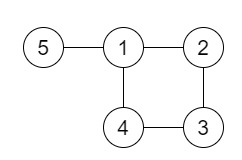
 Data Structure
Data Structure Networking
Networking RDBMS
RDBMS Operating System
Operating System Java
Java MS Excel
MS Excel iOS
iOS HTML
HTML CSS
CSS Android
Android Python
Python C Programming
C Programming C++
C++ C#
C# MongoDB
MongoDB MySQL
MySQL Javascript
Javascript PHP
PHP
- Selected Reading
- UPSC IAS Exams Notes
- Developer's Best Practices
- Questions and Answers
- Effective Resume Writing
- HR Interview Questions
- Computer Glossary
- Who is Who
Redundant Connection in C++
Suppose we have one unrooted tree; this is one undirected graph with no cycles. The given input is a graph that started as a tree with N nodes (values of the nodes are distinct values ranging from 1 through N), with one additional edge added. The added edge has two different vertices chosen from 1 to N, and was not an edge that already existed.
The final graph is given as a 2D-array of edges. Each element of edges is a pair [u, v] where u < v, that represents an undirected edge connecting nodes u and v.
We have to find an edge that can be removed so that the resulting graph is a tree of N nodes. There may be multiple answers, we have to find the answer that occurs last in the given 2Darray. The answer edge [u, v] should be in the same format, with u < v.
So, if the input is like [[1,2], [2,3], [3,4], [1,4], [1,5]],

then the output will be [1,4]
To solve this, we will follow these steps −
N := 1000
Define an array parent of size: N+5.
Define an array rank of size: N+5.
Define a function getParent(), this will take n,
-
if parent[n] is same as -1, then −
return n
return parent[n] = getParent(parent[n])
Define a function unionn(), this will take a, b,
pa := getParent(a), pb := getParent(b)
-
if pa is same as pb, then −
return false
-
if rank[pa] > rank[pb], then −
rank[pa] := rank[pa] + rank[pb]
parent[pb] := pa
-
Otherwise
rank[pb] := rank[pb] + rank[pa]
parent[pa] := pb
return true
From the main method, do the following −
n := size of edges list
-
for initialize i := 0, when i < n, update (increase i by 1), do −
parent[edges[i, 0]] := -1, parent[edges[i, 1]] := - 1
rank[edges[i, 0]] := -1, rank[edges[i, 1]] := 1
Define an array ans
-
for initialize i := 0, when i < n, update (increase i by 1), do −
u := edges[i, 0]
v := edges[i, 1]
-
if unionn(u, v) is zero, then −
ans := edges[i]
return ans
Example
Let us see the following implementation to get better understanding −
#include <bits/stdc++.h> using namespace std; void print_vector(vector v){ cout << "["; for(int i = 0; i<v.size(); i++){ cout << v[i] << ", "; } cout << "]"<<endl; } const int N = 1000; class Solution { public: int parent[N + 5]; int rank[N + 5]; int getParent(int n){ if (parent[n] == -1) return n; return parent[n] = getParent(parent[n]); } bool unionn(int a, int b){ int pa = getParent(a); int pb = getParent(b); if (pa == pb) return false; if (rank[pa] > rank[pb]) { rank[pa] += rank[pb]; parent[pb] = pa; } else { rank[pb] += rank[pa]; parent[pa] = pb; } return true; } vector<int> findRedundantConnection(vector<vector<int>>& edges) { int n = edges.size(); for (int i = 0; i < n; i++) { parent[edges[i][0]] = parent[edges[i][1]] = -1; rank[edges[i][0]] = rank[edges[i][1]] = 1; } vector<int> ans; for (int i = 0; i < n; i++) { int u = edges[i][0]; int v = edges[i][1]; if (!unionn(u, v)) { ans = edges[i]; } } return ans; } }; main(){ Solution ob; vector<vector<int>> v = {{1,2}, {2,3}, {3,4}, {1,4}, {1,5}}; print_vector(ob.findRedundantConnection(v)); } Input
{{1,2}, {2,3}, {3,4}, {1,4}, {1,5}} Output
[1, 4, ]

